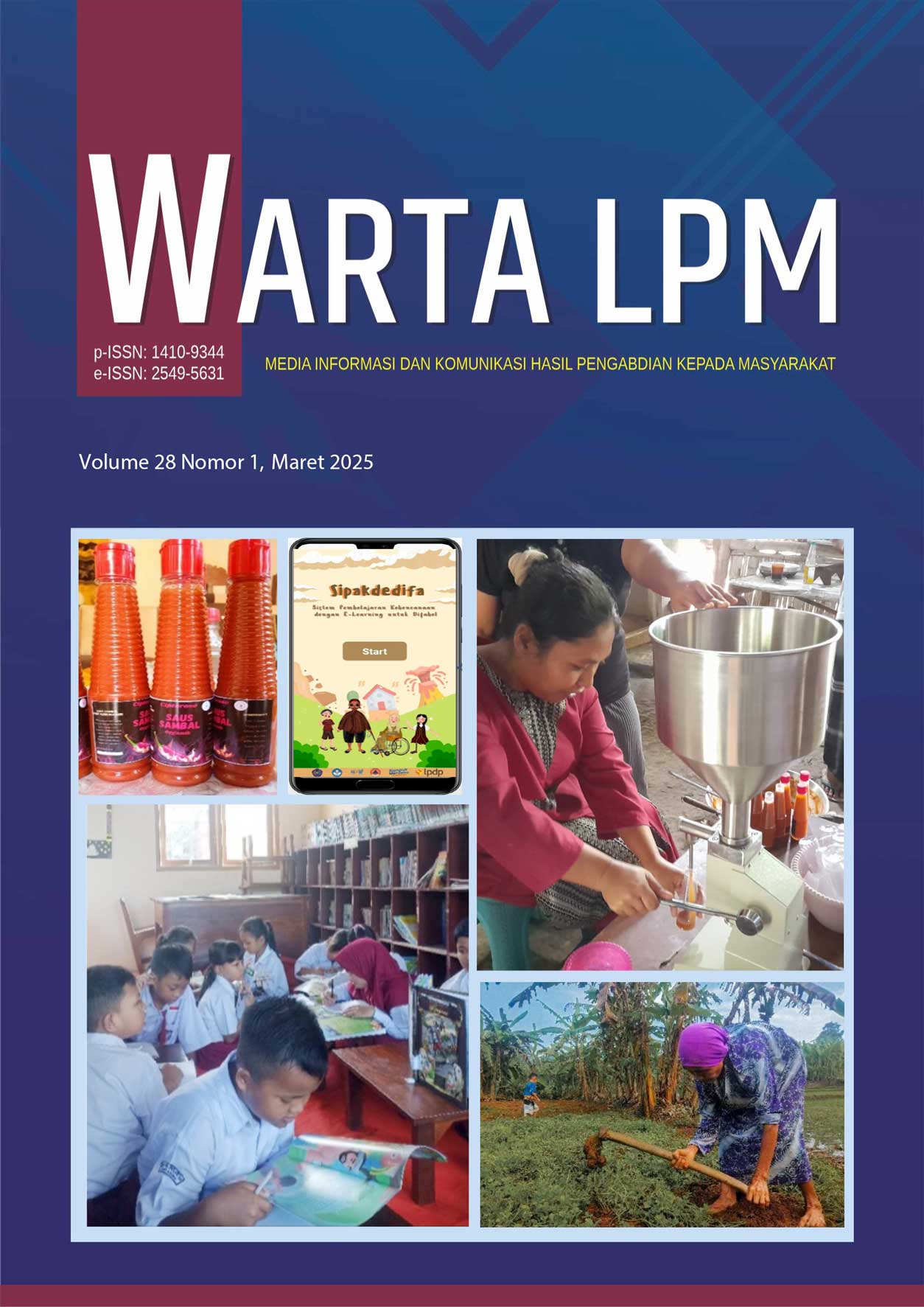Peran Lima Pilar STBM di Rumah Tangga dalam Menurunkan Angka Stunting di Wilayah Kerja Puskesmas Jayapura Utara
DOI:
https://doi.org/10.23917/warta.v27i1.7468Keywords:
Edukasi, Sanitasi Total Berbasis Masyarakat, stuntingAbstract
The prevalence of stunting in children is influenced by the state of sanitation in households. North Jayapura public health center is one of the public health centers in Jayapura City with the highest proportion of stunted children in 2020, at 26.3%. The objective of this initiative is to disseminate knowledge regarding the five fundamental principles of Community-Based Total Sanitation (STBM) within the domestic setting. The activity was conducted over a three-month period, from July to September 2024, within the operational scope of North Jayapura public health, the target population comprised women of childbearing age (WUS) or pregnant women (Bumil) and mothers with infants or toddlers who attended the Integrated Service Post (Posyandu). The number of target groups in this activity was 50 individuals, selected using the accidental sampling technique. The implementation of this activity employed a lecture method supported by animated images, followed by discussion and question-and-answer activities. The results of this activity demonstrated a statistically significant increase in knowledge, with an average gain of 12.0 points on a knowledge assessment of the five pillars of STBM in households, comparing the pre- and post-education groups, one statement, namely the one concerning septic tanks, has yet to achieve a satisfactory score. This is due to the fact that it is one of the methods used to treat household liquid waste.
Downloads
References
Amalina, A., Ratnawati, L.Y. and Bumi, C. (2023) ‘Hubungan Kualitas Air Konsumsi, Higiene, dan Sanitasi Rumah Tangga dengan Kejadian Stunting (Studi Case Control Pada Balita Stunting di Kabupaten Lumajang)’, Jurnal Kesehatan Lingkungan Indonesia, 22(1). Available at: https://doi.org/10.14710/JKLI.22.1.28-37.
Amouzou, A. et al. (2021) ‘Strengthening routine health information systems for analysis and data use: a tipping point’, BMC Health Services Research, 21(1). Available at: https://doi.org/10.1186/S12913-021-06648-1/METRICS.
Dinas Kesehatan Kota Jayapura (2023) Data Stunting Tingkat Kota Jayapura. Jayapura.
Dunn, L.S., Ceo-DiFrancesco, D. and Canto, A.S. (2023) ‘Immersion Not Just for Students Anymore’, International Journal for Research on Service-Learning and Community Engagement, 11(1). Available at: https://doi.org/10.37333/001C.91731.
Fatiah, M.S. et al. (2024) ‘Analisis situasi kejadian stunting pada bayi di bawah lima tahun (balita)’, Jurnal Inovasi Hasil Pengabdian Masyarakat (JIPEMAS), 7(1). Available at: https://riset.unisma.ac.id/index.php/jipemas/article/view/20785/16214 (Accessed: 15 October 2024).
Hanafi, A.S. et al. (2020) ‘Household Waste Management among Riverside Communities and other Determinants’, Media Kesehatan Masyarakat Indonesia, 14(4). Available at: https://doi.org/10.30597/MKMI.V14I4.5091.
Hasanica, N. et al. (2020) ‘The Effectiveness of Leaflets and Posters as a Health Education Method’, Materia Socio-Medica, 32(2), p. 135. Available at: https://doi.org/10.5455/MSM.2020.32.135-139.
Hoonakker, J.D. et al. (2023) ‘Use of visual aids in general practice consultations: A questionnaire-based survey’, PEC Innovation, 2. Available at: https://doi.org/10.1016/J.PECINN.2023.100159.
Irjayanti, A., Fatiah, M.S. and Irmanto, M. (2024) ‘Faktor Langusng dan Tidak Langsung dengan kejadian Stunting’, Junral Kesehatan Kusuma Husada, 15(2). Available at: http://jurnal.ukh.ac.id/index.php/JK/article/view/1241/616 (Accessed: 14 October 2024).
Irjayanti, A., Irmanto, M. and Wibowo, T.F. (2024) ‘Analisis Faktor Risiko Diare Pada Balita di Wilayah Kerja Puskesmas Jayapura Utara’, Jurnal Kesehatan Lingkungan Indonesia, 23(1). Available at: https://doi.org/10.14710/JKLI.23.1.1-9.
Jafar, N. et al. (2023) ‘Enhancing knowledge of Diabetes self-management and quality of life in people with Diabetes Mellitus by using Guru Diabetes Apps-based health coaching’, Journal of Public Health Research, 12(3). Available at: https://doi.org/10.1177/22799036231186338/ASSET/IMAGES/LARGE/10.1177_22799036231186338-FIG3.JPEG.
Jihadi, H. et al. (2024) Developing Simple Android Applications On Websites With MIT App Inventor For Students Of SMAN 4 Bogor City, International Journal of Community Services. Available at: https://ijcsnet.id/index.php/go/article/view/281/260 (Accessed: 14 October 2024).
Kanda, A., Ncube, E.J. and Voyi, K. (2021) ‘Effect of sanitation interventions on health outcomes: A systematic review of cluster-randomized controlled trials in rural communities of low-and middle-income countries’, International Journal of Environmental Research and Public Health, 18(16). Available at: https://doi.org/10.3390/IJERPH18168313/S1.
Kementerian Kesehatan RI (2018) Situasi Balita Pendek (Stunting) di Indonesia, Pusat Data dan Informasi Kementerian Kesehatan RI. Jakarta.
Kementerian Perencanaan dan Pembangunan Nasional and Badan Perencanaan dan Pembangunan Nasional (2018) ‘Pedoman Pelaksanaan Intervensi Penurunan Stunting Terintegrasi di Kabupaten/Kota’, Rencana Aksi Nasional dalam Rangka Penurunan Stunting: Rembuk Stunting [Preprint], (November).
Lee, J.M. et al. (2023) ‘Public health emergency preparedness for infectious disease emergencies: a scoping review of recent evidence’, BMC Public Health, 23(1). Available at: https://doi.org/10.1186/S12889-023-15313-7/TABLES/2.
Lusiana, A. et al. (2023) ‘The Effectiveness of Health Education by Family Planning Development Group (BKR) with Media E Booklet and Module on Parents’ Attitudes in Facing Adolescent Reproductive Health Problems’, in. Semarang: Universitas Negeri Semarang. Available at: https://proceeding.unnes.ac.id/index.php/iset.
Paramashanti, B.A. et al. (2023) ‘Factors influencing breastfeeding continuation and formula feeding beyond six months in rural and urban households in Indonesia: a qualitative investigation’, International Breastfeeding Journal, 18(1). Available at: https://doi.org/10.1186/S13006-023-00586-W/TABLES/2.
Patimah, S. et al. (2024) ‘Pendampingan Pencegahan Risiko Anak Stunting pada Masyarakat, Kader Kesehatan, dan Guru PAUD/TK’, Warta LPM, 27(2). Available at: https://journals2.ums.ac.id/warta/article/view/3760/1831 (Accessed: 15 October 2024).
Ravaghi, H. et al. (2023) ‘A scoping review of community health needs and assets assessment: concepts, rationale, tools and uses’, BMC Health Services Research 2023 , 23(1). Available at: https://doi.org/10.1186/S12913-022-08983-3.
Saputra, N. et al. (2024) ‘Prevention Of Early Marriage As An Effort To Overcome Stunting’, International Journal of Community Service, 4(3). Available at: https://ijcsnet.id/index.php/go/article/view/292/261 (Accessed: 15 October 2024).
Schmidt, B.M. et al. (2020) ‘Definitions, components and processes of data harmonisation in healthcare: a scoping review’, BMC Medical Informatics and Decision Making, 20(1). Available at: https://doi.org/10.1186/S12911-020-01218-7/FIGURES/3.
Shalash, A. et al. (2022) ‘The need for standardised methods of data collection, sharing of data and agency coordination in humanitarian settings’, BMJ Global Health, 7(8). Available at: https://doi.org/10.1136/BMJGH-2021-007249.
Sugiarti, N., Rusmawati, A. and Yalestyarini, E.A. (2021) ‘The Efforts of Posyandu Cadres in Increasing Mother’s Awareness Behavior in Maintaining Baby’s Development: Literature Review’, Open Access Health Scientific Journal, 2(1). Available at: https://doi.org/10.55700/OAHSJ.V2I1.16.
UNICEF, WHO and World Bank Group (2021) Levels and Trends in Child Malnutrition. New York. Available at: https://globalnutritionreport.org/documents/753/2021_Global_Nutrition_Report.pdf.
UNICEF, WHO and World Bank Group (2023) Levels and Trends in Child Malnutrition UNICEF/WHO/World Bank Group Joint Child Malnutrition Estimates Key Findings of the 2023 edition . Available at: https://iris.who.int/bitstream/handle/10665/368038/9789240073791-eng.pdf?sequence=1 (Accessed: 18 January 2024).
WHO (2020) Health Information Systems: Data Collection Tools. Geneve: WHO. Available at: https://www.who.int/health-topics/data-collection (Accessed: 14 October 2024).
Yusdiana and Dewi, A.S. (2022) ‘Overview of the Knowledge of Mothers of Toddlers Who Visit Posyandu Melayu Besar, Rokan Hilir District’, in 4th Riau Medical Scientific and Expo 2022. Riau. Available at: http://dx.doi.org/10.11594/nstp.2022.2805 (Accessed: 15 October 2024).
Downloads
Submitted
Accepted
Published
How to Cite
Issue
Section
License
Copyright (c) 2025 Warta LPM

This work is licensed under a Creative Commons Attribution 4.0 International License.















